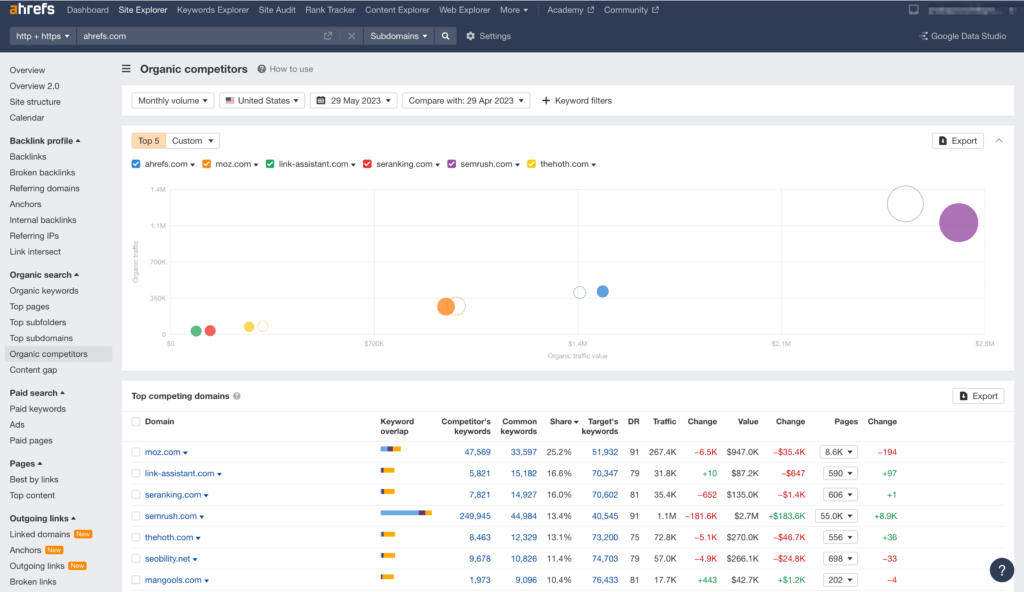
In the ever-evolving realm of Search Engine Optimization (SEO), staying ahead of the competition is vital for success. With millions of websites vying for visibility and user attention, it’s crucial to have a strategy that sets you apart. That’s where competitor analysis comes into play — a powerful tool that uncovers valuable insights about your rivals and helps you gain a competitive edge.
In the forthcoming sections, we’ll delve into the step-by-step process of conducting SEO competitor analysis, providing you with practical guidance and actionable insights. We’ll also share a curated list of the best SEO competitors analysis tools to streamline your research and empower your SEO endeavors.
Are you ready to unlock the secrets to SEO success? Then let’s move on to competitor analysis and take your digital presence to new heights. Remember, in the fierce arena of SEO, knowledge is power, and competitor analysis is your secret weapon.
What is Competitive Analysis in SEO?
Competitive analysis forms the bedrock of effective SEO strategies. It’s the process of evaluating and understanding the digital landscape of your industry, analyzing the strengths and weaknesses of your competitors, and leveraging that knowledge to refine your own SEO efforts.
At its core, a competitive SEO audit involves examining various factors that contribute to your competitors’ online success. This includes evaluating their:
- • website traffic;
- • rankings on search engine result pages (SERPs);
- • keyword strategies;
- • content quality;
- • backlink profiles;
- • SEO budgets.
By conducting a comprehensive SEO competitive analysis, you gain a panoramic view of your industry’s digital ecosystem. It allows you to identify the key players who are dominating the search results, understands their tactics, and uncover opportunities for improvement and differentiation. Partnering with a professional SEO company can further enhance your competitive analysis efforts, as they bring expertise, experience, and specialized tools to help you gain a competitive advantage in the ever-evolving online presence.
Why Competitor Analysis is Important in SEO
Competitor analysis is a critical component of an effective SEO strategy, offering numerous benefits that can propel your digital presence to new heights. Let’s explore the key reasons why SEO competitor review should be an integral part of your efforts:
1. Uncover Best Practices and Strategies
Competitor SEO analysis allows you to learn from the success and failures of your rivals. By studying their strategies, you can identify the tactics and techniques that yield positive SEO results. This knowledge empowers you to adopt and adapt these best practices, saving you time and effort in experimenting with different approaches.
2. Identify New Opportunities
Analyzing your search competitors helps you uncover untapped opportunities within your industry. By examining their keyword targeting, content gaps, or areas with low competition, you can discover new avenues for growth. This allows you to expand your reach and attract a wider audience by capitalizing on unexplored niches.
3. Benchmark Your Performance
Competitor analysis for SEO provides a benchmark for evaluating your own performance. By comparing your website’s metrics, such as traffic, rankings, and types of backlinks, with those of your SERP competitors, you gain a clearer understanding of where you stand in the competitive landscape. This insight helps you set realistic goals and devise strategies to outperform your rivals.
4. Refine Your Keyword Strategy
Understanding the focus keywords your competitors target is invaluable in optimizing your own keyword strategy. By identifying the high-performing keywords they rank for, you can refine your keyword selection, focus on long-tail variations, and uncover new keyword opportunities. This enables you to align your content with user intent and increase your chances of ranking higher in search results.
5. Enhance Content Quality and Relevance
Analyzing your competitors’ content allows you to assess their strengths and weaknesses. By understanding the type of content that resonates with your shared audience, you can create higher-quality, more engaging, and informative content that stands out. This not only improves your search engine visibility but also establishes your brand as an authoritative source of information.
6. Improve Link Building Strategies
Backlinks are crucial for SEO success, and competitor analysis helps you identify potential linking opportunities. By analyzing your rivals’ backlink profiles, you can discover authoritative websites, industry influencers, and content creators that may be open to collaboration. This enables you to build strong, relevant, and high-quality backlinks, boosting your website’s authority and visibility.
7. Stay Ahead of Trends and Changes
The digital landscape is constantly evolving, with new trends, algorithms, and strategies emerging regularly. Competitor analysis helps you stay informed and adapt to these changes. By monitoring your rivals’ SEO activities, you can identify emerging trends, spot shifts in user behavior, and quickly adjust your strategies to maintain a competitive edge.
8. Optimize Resource Allocation
Understanding your competitors’ SEO budgets provides insights into their investments and priorities. This knowledge helps you optimize your own resource allocation, ensuring you allocate your budget, time, and effort where it matters most. By focusing on areas with the highest potential for ROI, you can maximize your impact and achieve better results.
In summary, competitor analysis is vital in SEO as it enables you to learn from your competitors, discover new opportunities, benchmark your performance, refine your strategies, and adapt to a dynamic digital world. By leveraging the insights gained from competitor analysis, you can position yourself as a frontrunner in your industry and achieve sustainable organic growth.
To help businesses and website owners navigate the ever-changing space of search engine optimization, Google provides a comprehensive resource known as the “Google SEO Guide.” This guide offers valuable insights, tips, and guidelines directly from Google itself, empowering you to make informed decisions and optimize your website for better search visibility.

How to Do SEO Competitor Analysis
Competitor analysis is a systematic process that involves several key steps to gain valuable insights into your rivals’ SEO strategies. By following these steps, you can uncover valuable information, identify opportunities, and refine your own SEO approach. Let’s explore the process of conducting SEO competitor analysis:
Find SEO Competitors
To begin, you need to make competitor research to identify your SEO competitors. These are the websites that compete with you for visibility in search engine results. Start by selecting competitors who are in the same business type or industry as you. Look for websites that target similar keywords and attract a similar target audience.
While choosing competitors, consider those who are weaker or on par with you in terms of initial parameters such as domain rating, domain age, and number of pages. However, pay attention to those competitors who are getting more traffic and ranking higher for the keywords you’re targeting. Analyzing their strategies will provide valuable insights and reveal potential opportunities for improvement.
Compare Competitor Website Traffic
Analyzing the website traffic of your competitors is crucial for understanding their digital reach and popularity. Tools like SimilarWeb or SEMrush can provide estimates of website traffic for your competitors. By comparing their traffic metrics with your own, you can gain a clearer understanding of their online presence and identify areas where you can improve.
Check Your SERP Competitors’ Rankings
It’s essential to evaluate how your competitors are performing in search engine rankings. Identify the keywords they are targeting and analyze their positions in the search results. Tools like SEMrush or Ahrefs can provide valuable data on keyword rankings. By understanding your competitors’ rankings within the context of Google’s ranking systems, you can refine your own keyword targeting and optimization strategies to increase your visibility and attract more organic traffic.
Conduct Competitor Keyword Research
Keyword research is a vital aspect of competitor analysis. Analyze the keywords your competitors are targeting to gain insights into their content strategy. Tools like SEMrush, Google Keyword Planner, or Moz Keyword Explorer can help you to conduct competitor keyword analysis and identify the keywords your competitors rank for. This information allows you to uncover new keyword opportunities, refine your own keyword targeting, and optimize your content to align with user intent.
Perform Competitors’ Content Analysis
Analyzing your competitors’ content helps you understand their strengths, weaknesses, and content gaps. Assess the quality, depth, and relevance of their content compared to yours. Identify the topics they cover, the formats they use, and the engagement they receive. This competitive research analysis enables you to optimize content making it more valuable, engaging, and comprehensive that outperforms your competitors.
Analyze Competitors’ Featured Snippets
Featured snippets are highly visible positions at the top of search results. Analyze the featured snippets your competitors occupy to understand the type of content that captures these positions. Study the format, structure, and information provided in these snippets. By optimizing your content for featured snippets, you can increase your visibility and attract more organic traffic.
Check Competitors’ Backlinks
Backlinks play a crucial role in SEO. Analyzing your competitors’ backlink profiles helps you identify potential linking opportunities and discover authoritative websites for collaborations. Tools like Ahrefs or Majestic can provide insights into your competitors’ backlinks. While comprehensive competitor research of backlinks is beyond the scope of this article, you can refer to our separate article on competitor backlinks analysis for a more detailed exploration of this topic.
Estimate the SEO Budget of Your Competitors
Understanding your competitors’ SEO budgets provides insights into their investments and priorities. While it can be challenging to determine exact figures, you can make estimates based on their activities and the resources they allocate to SEO. This knowledge helps you optimize your own resource allocation and budget, ensuring you focus on areas that offer the highest potential for return.
Track Competitors’ SEO Continuously
Competitor analysis is not a one-time task; it requires ongoing monitoring and tracking of your competitors’ SEO activities. By continuously observing their strategies and adapting accordingly, you can stay ahead of the game, stay informed about industry trends, adapt your strategies, and maintain a competitive advantage. Remember that SEO competitor audit is an iterative process, and staying vigilant allows you to identify new opportunities and optimize your SEO approach effectively.

Best SEO Competitor Analysis Tools
In the world of SEO competitor analysis, having the right tools at your disposal can make a significant difference in gaining valuable insights and staying ahead of the SEO competition. Here are some of the top SEO competitors’ analysis tools that we mentioned above and that can assist you in uncovering crucial data and optimizing your strategies:
- • Ahrefs: Ahrefs is an all-in-one SEO tool that offers comprehensive competitor analysis features. With Ahrefs, you can explore your competitors’ backlink profiles, analyze their organic search traffic, track keyword rankings, and identify content gaps. Its powerful suite of tools enables you to gain a deep understanding of your rivals’ SEO strategies.
- • SEMrush: SEMrush is another popular tool that provides a wide range of features for competitor analysis. You can conduct keyword research to identify your competitors’ top-ranking keywords, analyze their backlink profiles, track their website traffic, and monitor their social media presence. SEMrush’s competitive intelligence allows you to benchmark your performance against your rivals and make data-driven decisions.
- • Moz: Moz offers a suite of SEO tools that includes competitor analysis functionalities. With Moz, you can uncover your competitors’ top-ranking keywords, analyze their domain authority and link profiles, and track their search visibility. Moz’s tools provide valuable insights for optimizing your own SEO strategies and improving your search rankings.
- • SimilarWeb: SimilarWeb is a powerful competitive SEO analysis tool that provides comprehensive data on your competitors’ website traffic, engagement metrics, referral sources, and audience demographics. With SimilarWeb, you can gain a holistic view of your rivals’ online presence and identify opportunities to outperform them.
- • SpyFu: SpyFu specializes in competitor keyword research and analysis. It allows you to uncover the keywords your competitors are ranking for, identify their ad campaigns, and analyze their ad spend. With SpyFu, you can gain insights into your rivals’ PPC strategies and optimize your own campaigns accordingly.
- • Google Keyword Planner: Google Keyword Planner is a free tool provided by Google Ads. It helps you discover keywords related to your industry and provides data on search volume, competition, and suggested bids. While primarily used for keyword research, it can also assist in identifying the keywords your competitors are targeting.
- • Buzzsumo: Buzzsumo focuses on content analysis and social media engagement. It allows you to identify the most shared content from your competitors, understands which topics resonate with their audience, and discover influential content creators in your industry. Buzzsumo’s insights can guide your content strategy and help you create more engaging and shareable content.
These are just a few examples of the many SEO competitor analysis tools available. Each tool offers unique features and functionalities, so it’s important to choose the ones that align with your specific needs and goals. By leveraging these tools, you can gain valuable insights, refine your SEO strategies, and gain a competitive edge in the digital landscape.
The Importance of Competitor Analysis: Conclusions
Competitor analysis is a fundamental aspect of SEO strategy that should not be overlooked. By thoroughly understanding your competitors’ tactics, strengths, and weaknesses, you can make informed decisions to optimize your own SEO efforts. Uncover new opportunities, refine your SEO strategy, stay ahead of the competition, enhance user experience, and optimize content creation – these are just the main benefits of competitor analysis for your business.
At Mellow Promo, we understand the significance of competitor analysis in achieving SEO success. Our experienced team specializes in conducting thorough competitor analysis to provide you with actionable insights. We offer comprehensive SEO competitor analysis services tailored to your specific industry and goals. With our expertise and advanced tools, we delve into the strategies of your competitors, uncovering valuable data and opportunities for your business. From identifying keyword gaps to analyzing backlink profiles, we provide you with a comprehensive view of the competitive landscape, empowering you to make data-driven decisions.
Don’t let your competitors outshine you in the digital realm. Contact Mellow Promo today to leverage the power of SEO competitor analysis and gain a competitive advantage in the ever-evolving online world. Let us help you navigate the complexities of SEO and propel your business to new heights!
FAQs
What is an SEO competitor?
An SEO competitor refers to a website or business that competes with your own in the search engine rankings for relevant keywords and targets a similar audience.
How to choose the right competitors in SEO?
To choose the right competitors in SEO, you can consider their rankings for target keywords, and business type, and use tools like Ahrefs or SEMrush to identify competitors with similar parameters and higher rankings.
What should a competitor analysis include?
A comprehensive competitor analysis should include an assessment of their backlink profile, keyword rankings, content strategy, website traffic, social media presence, and overall SEO performance.
How to find competitor keywords?
Competitor keywords can be found using tools like SEMrush or Ahrefs, which allow you to analyze your competitors’ keyword rankings and identify the keywords they are targeting.
How to check competitor website traffic?
You can analyze competitor website traffic using tools like SimilarWeb, which provides insights into their traffic volume, sources, and audience demographics.
What is the best SEO tool for competitor site analysis?
Some of the best SEO tools for competitor site analysis include Ahrefs, SEMrush, Moz, and SimilarWeb, as they offer comprehensive features for analyzing backlinks, keyword rankings, website traffic, and more.





